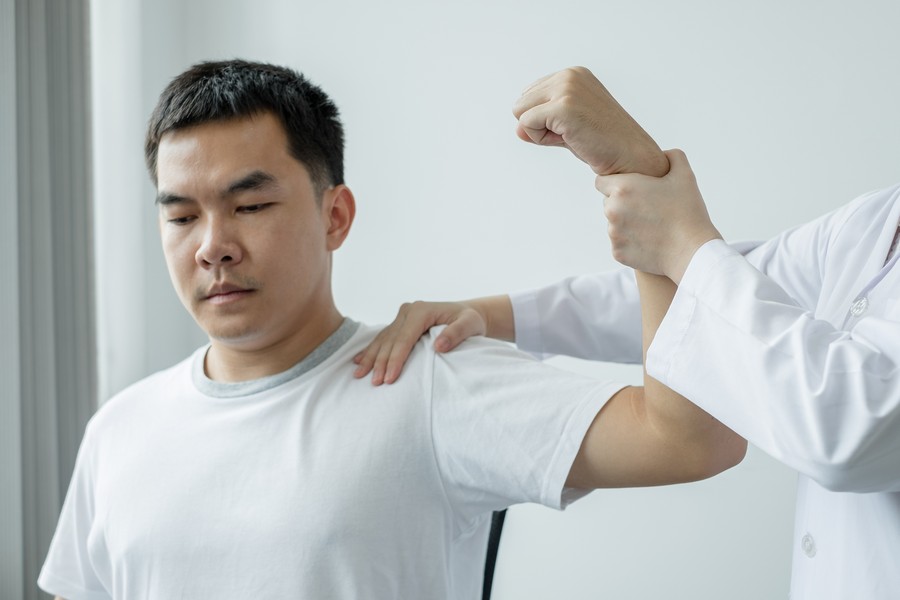Physiotherapy for Rotator Cuff Tears
 Shoulder pain is a common complaint in the primary care setting, with studies reporting that it’s the third most common musculoskeletal complaint. Shoulder pain accounts for about 1-2.4% of adult visits to primary care providers each year, and approximately 65% of these visits are due to rotator cuff issues, including tears and tendinopathy.
Shoulder pain is a common complaint in the primary care setting, with studies reporting that it’s the third most common musculoskeletal complaint. Shoulder pain accounts for about 1-2.4% of adult visits to primary care providers each year, and approximately 65% of these visits are due to rotator cuff issues, including tears and tendinopathy.
What Is the Rotator Cuff?
Four muscles make up the rotator cuff, including supraspinatus, infraspinatus, teres minor, and subscapularis. The rotator cuff helps to stabilize the shoulder and helps to rotate and lift the arm.
A rotator cuff tear is a partial or complete tear of one or more of the tendons that attach the muscles of the rotator cuff to the bone.
Causes of Rotator Cuff Tears
There are two main causes of rotator cuff tears: degeneration and injury. Degenerative rotator cuff tears are more common and occur due to poor posture and alignment, and wear and tear of the tendon over time (which occurs naturally with aging). Acute rotator cuff tears are usually the result of injury and can occur on their own or with another shoulder injury, such as a dislocated shoulder.
Symptoms of Rotator Cuff Tears
Some common symptoms of rotator cuff tears include:
- Pain in the front of the affected shoulder that may radiate down the arm
- Pain that is worse with overhead activities
- Pain when lying on the affected shoulder
- Weakness of the affected arm
- Swelling and inflammation of the affected shoulder
- Decreased range of motion of the affected shoulder
- Snapping or cracking sensation when moving the affected shoulder
If the tear is the result of injury, symptoms may include acute pain, immediate arm weakness, and a snapping sensation.
Treatment of Rotator Cuff Tear
The good news is that most rotator cuff tears can be treated conservatively without the need for surgery. Conservative treatment options include:
- Anti-inflammatory and pain medications
- Subacromial injection of local anesthetics and/or steroids
- Physiotherapy
- Activity modification
The goals of conservative treatment are to relieve pain and inflammation, improve muscle strength, and regain normal functioning of the affected shoulder.
While most rotator cuff tears can be successfully treated conservatively, surgery may be necessary in some cases. Surgery may be recommended for people who have persistent pain and weakness despite conservative treatment, people who use the affected shoulder for work or sports, or people who have acute complete tears resulting from trauma.
The Role of Physiotherapy in Rotator Cuff Tears
If you have symptoms of a rotator cuff tear, you should be evaluated by a physiotherapist. They will take a detailed history of your symptoms and perform a thorough physical exam to evaluate your shoulder. After your assessment, your physiotherapist will create an individualized program that is specific to your needs. Treatment may include a combination of therapies such as ice, heat, soft tissue and manual therapy, ultrasound, electric stimulation, and posture correction. Your physiotherapist will also provide you with stretching and strengthening exercises and teach you proper body mechanics for lifting. Further, they will educate you on how to protect your shoulder to prevent further injury and complications.
Physiotherapy can be beneficial for both acute and chronic rotator cuff tears and can also help after surgery. Physiotherapy can help you manage your rotator cuff tear symptoms and regain normal functioning of your shoulder to help improve your quality of life.
References
- Mathiasen R, Hogrefe C. Evaluation and management of rotator cuff tears: A primary care perspective. Curr Rev Musculoskelet Med. 2018;11(1):72-76. doi:10.1007/s12178-018-9471-6
- The Academy of Orthopaedic Surgeons. Rotator cuff tears: Frequently asked questions. Retrieved November 10, 2023. Available at https://orthoinfo.aaos.org/en/diseases--conditions/rotator-cuff-tears-frequently-asked-questions/.
- Weber S, Chahal J. Management of rotator cuff injuries. Journal of the American Academy of Orthopaedic Surgeons. 2020;28(5).
- Sambandam SN, Khanna V, Gul A, Mounasamy V. Rotator cuff tears: An evidence-based approach. World J Orthop. 2015;6(11):902-918. doi:10.5312/wjo.v6.i11.902